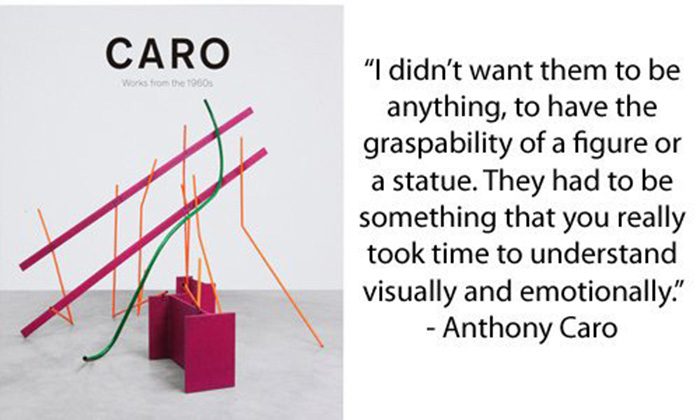BOOK:Caro Works from the 1960’s, Publisher: Gagosian/Rizzoli
 Over the course of his 60-year career, Anthony Caro continuously reimagined the relationship between viewer and sculpture. From his beginnings as an assistant to Henry Moore during the early ‘50s, he worked to contort the figure to the brink of abstraction. Following a pivotal trip to the U.S.A. in 1959, Caro began a new approach to form, color, and presentation. Inspired by David Smith’s transposing of impulsive painterly lines into welded and forged metal, he cultivated an original lyricism from industrial steel and aluminum parts.
Over the course of his 60-year career, Anthony Caro continuously reimagined the relationship between viewer and sculpture. From his beginnings as an assistant to Henry Moore during the early ‘50s, he worked to contort the figure to the brink of abstraction. Following a pivotal trip to the U.S.A. in 1959, Caro began a new approach to form, color, and presentation. Inspired by David Smith’s transposing of impulsive painterly lines into welded and forged metal, he cultivated an original lyricism from industrial steel and aluminum parts.
By Efi Michalarou
This catalogue presents 14 early sculptures by the late artist, presented on 14/4-30/5/16, at the Gagosian Galley at Beverly Hills. Documented in vivid color photographs, these exuberant sculptures depict Anthony Caro’s decision to bypass representational imagery, and to use bright colors to synthesize the bolted and welded metal parts that replaced it. Along with installation shots and historical photographs, this book includes a new essay from Tim Marlow that tracks Caro’s development as a sculptor, as well as Rosalind Krauss’s 1967 Art International article on the artist and the nature of sculpture. The works are characterized by tensions between elements that are upright and leaning; rigid and curved; rectilinear and inflected, from the bright orange “Capital” (1960), in which a large steel square levitates beside fixed, level components to “Drop” (1966), a straight yellow beam interrupted by an incongruous curve.
